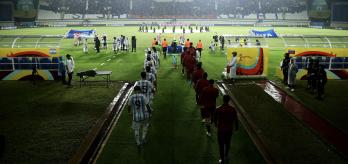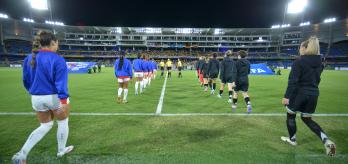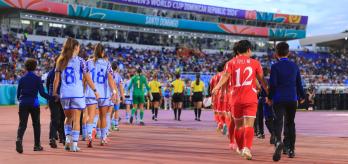Key take-aways
-
More than three-quarters of players at the FIFA U-20 World Cup play for top-division clubs (77.8%) with percentages ranging from 100% for Argentina and Uruguay to just one-third for Nigeria.
-
The majority of players play for a club in the national association they represented (79.8%). Footballers playing abroad either grew up there or went abroad because of international recruitment.
-
The Relative Age Effect exists. Players born between January and March are over-represented (36.7% of all players), while those born in the last quarter of the year are clearly under-represented (16.7%).
Introduction
This article is the result of a collaboration between FIFA High Performance and the CIES Football Observatory research group. It analyses the composition of the national teams qualified for the FIFA U-20 World Cup currently taking place in Argentina. For this purpose, we analysed the 504 players selected, their clubs and leagues of employment, as well as their birth dates.
The main observations of the qualified national teams:
-
All six confederations are represented with a maximum of five for UEFA and CONMEBOL and a minimum of two for OFC, with AFC, CAF and CONCACAF represented by four teams.
-
Two associations are participating in a U-20 World Cup final tournament for the first time, the Dominican Republic and Israel.
-
Five participating nations have already won the trophy: hosts Argentina (six times), Brazil (five times), France (once) and England (once).
Leagues and clubs of employment
Almost four-fifths of players called up for the FIFA U-20 World Cup play for clubs in the top division of their respective associations. This percentage is particularly high in CONMEBOL (93.3%) and CONCACAF (89.3%), where elite clubs do not hesitate to integrate the best young talents into their ranks. The relatively low percentage measured in UEFA (65.7%) could be due to the reluctance of Italian Serie A and English Premier League clubs to give young national players opportunities (see also below).
All of the players selected by Argentina and Uruguay play for top division clubs. This reflects the emphasis on young local talent in these leagues, where the clubs’ business model is heavily focused on developing and transferring them to richer teams. At the other end of the spectrum is Nigeria, where the elite clubs are not very active in youth development, with this work being done primarily by private academies that do not participate in the national top flight.
The relatively low proportion of Japanese and South Korean players in top divisions is linked to two main factors: the importance of high schools and universities with no affiliation to professional clubs in the training of top level footballers, and the reluctance of top flight clubs to give young players a chance, as the start in professional football in these countries generally occurs later than elsewhere.
In terms of the share of footballers playing for clubs in the association represented, four-fifths of FIFA U-20 World Cup participants are in this category. The highest percentage was measured at UEFA level (89.5%), while the lowest was measured for CAF selections (71.5%). This result can be explained both by the tendency of African players to go abroad at a very young age, but also by the selection of footballers born outside their country of origin.
The two associations with the most players playing abroad are Tunisia and the Dominican Republic (see Figure 4.2).
Players' date of birth
The analysis of the date of birth of players called up allows us to understand their distribution by year and month of birth. In terms of year of birth, although most of the players were logically born in 2003, a significant proportion were born in 2004 or later (42.1%). Six selected players were born in 2006 and the two youngest even in 2007: Daniel Daga (Nigeria) and Kendry Páez (Ecuador).
The analysis by month of birth makes it possible to test the existence of a Relative Age Effect (RAE). This concept refers to the usual over-representation of players born in the months closest to the selection cut-off date chosen to define an age category, in this case January 1st. These athletes generally have a competitive advantage due to their advanced age compared to players born later in the year. Across the sample, this effect is clearly confirmed with 36.7% of players born in the first quarter of a year, compared to 24.4% in the second, 22.2% in the third and 16.7% in the last quarter.
The RAE exists for both players born in 2003 (31.8% born in the first quarter) and those born in 2004 (45.5% born in the first quarter). The advantage of being born early in the year therefore extends beyond the first year of eligibility. In this specific case, in absolute terms, there are even more players born in the first quarter of 2004 (75 selected) than in the last quarter of 2003 (58 selected).
This result can be explained by the fact that footballers born between October and December are more likely to be rejected by both the best training clubs and national youth teams, which puts them relatively more often in a dead-end street from which it is subsequently difficult to escape. This notably happens to the benefit of players born between January and March of the following year, and therefore even younger, but who had a RAE advantage for their year of birth, which eased their retention in the best training paths.
The RAE exists in all confederations, although the extent to which it occurs varies based on each region. The highest percentage of players born in the first quarter was recorded in UEFA (46.7%), followed by OFC (42.9%), CONMEBOL (37.1%) and CONCACAF (36.9%). Considering the first half of the year, an overrepresentation was found for all confederations with percentages ranging from 64.8% in CONMEBOL to 54.8% in CAF. The data per association can be found in Figure 7 in the Annex.
Conclusion
More than three-quarters of the players at the FIFA U-20 World Cup play for top-division clubs (77.8%), with percentages ranging from 100% for Argentina and Uruguay to just one-third for Nigeria. These discrepancies reflect the different roles played by elite clubs in the training of footballers: a very important role in South America and a much less important one in Africa.
Most of the players selected play for a club in the national association represented (79.8%). Footballers playing abroad either grew up there, as in the case of many of the players selected by the Dominican Republic and Tunisia, or went abroad because of international recruitment, as in the case of Argentinian midfielder Máximo Perrone, transferred from Velez Sarsfield to Manchester City in January 2023.
The article also highlights the existence of a relative age effect. Players born between January and March are over-represented (36.7% of all players), while those born in the last quarter of the year are clearly under-represented (16.7%). This effect is particularly marked within the UEFA selections, with 46.7% of players born between January and March and only 17.1% between October and December. This finding confirms the need to take into account the month of birth and biological age of players in the selection process.





















